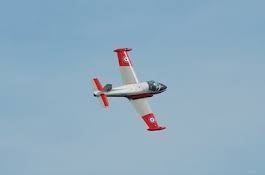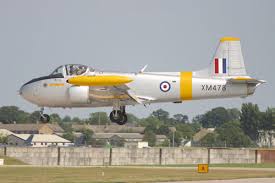SLOPING OFF...
...the Newsletter of Christchurch and District Model Flying Club for March 2021
I didn’t learn about flying from that: well maybe a little bit
by Jon Goddard

This tale is really about how dangerous it is to be inexperienced.
Throughout 1963 I was undergoing Basic Flying Training at RAF Syerston which is near Newark in Nottinghamshire. The syllabus included about fifteen navigation exercises both dual and solo. The course was split into two halves – the first 70 hours on the JP3 and the balance of 90 hours on the JP4 which was much more powerful.
The highlight of the Navex’s were the two low level ones in the JP3. There were two more on the JP4 but I’d learnt a lot more by then. The low level trips were flown at 500’ and 250 knots which doesn’t sound very fast or very low level but I can assure you were quite taxing. The routes were down to somewhere near Peterborough and a number of turning points in the Fenlands and Lincolnshire ending up in Yorkshire. The problem with this route was that at 500’ you could only see power lines and village church steeples, everything else went past too fast to be of use. There are an awful lot of villages in that part of the world all with churches; the net result was that you were never sure of exactly where you were except when some prominent feature cropped up.
You did the route dual first with your instructor whinging at you to stop climbing to see where you were and then you were let loose on your own. I was on my solo trip and enjoying the experience and at about halfway I was following a railway line which went round the side of Market Rasen. This meant I was on track and I started to relax a bit. Along came an old fashioned signal box out in the sticks. It was just too tempting and I put the nose down to attack it. At about 100’ there was a blur from right to left and a loud thump by my left knee. This almost certainly meant my engine had ingested a bird. The Jet Provost was powered by the Armstrong Siddeley Viper engine which was designed as a cheap disposable engine to power the Jindivic pilotless drone and was not as robust as modern engines. It usually failed if it ingested a bird and if you were unfortunate enough to have this happen you were supposed to leave the throttle alone trade speed for height and eject if the engine lost power. The other rule was that if you climbed you were to return to base and you didn’t get another go at the Navex.
So what did I do? I slammed the throttle to full power and as I didn’t want to lose the rest of the trip I stayed low level. After a minute or so I began to worry about what I’d done so I called base for advice. UHF radios are line of sight and so all they heard was my call sign and a garbled message about ingesting a bird. I gather there was much panic in the tower (well, consternation anyway). They managed to get a message to me to climb, eject if I lost power and return to base if I could. So I climbed to 2000’ and turned onto a rough heading for Syerston. The Tower gave me a correct heading and the Duty Instructor asked if I had done a low speed check. So I closed the throttle and did a straight stall right over Lincoln Cathedral. The minimum height for stalling was 8,000’ and not over built up areas!
I realised I wasn’t getting this right so I started to sort myself out. They told me to join the circuit for a landing but as I was dead in line with the duty runway over Newark I said I was doing a straight in approach. As I approached the threshold I noticed the Station Commanders car by the touch down point and the airfield littered with fire engines and ambulances. I didn’t find this very reassuring.

Fortunately I pulled off a good landing and taxied in to the dispersal. After I shut the engine down an airman climbed into the intake and retrieved a dead swallow. The two intakes met in front of the engine and there was a sort of nose cone there onto which the bird had impaled itself. Had it not done so I would almost certainly had to eject as the engine would have failed.
What followed was a lot of form filling – Special Occurrence Report – and I was commended for bringing the aircraft back in one piece. If only they knew the truth of what had really happened!! The old RAF unofficial rule was the crime was in getting caught not what you did.
I am not sure what I learnt at the time but I certainly realised later in my career that inexperienced people do strange things.